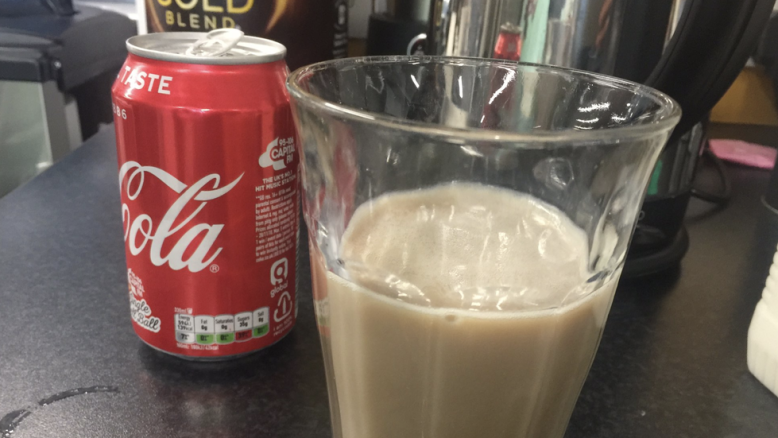
Comedian James Felton Tweeted about drinking milk coke, declaring it is “a real thing.” The slogan for Coca-Cola happens to be “It’s the real thing.” Milk coke is milk and Coca-Cola mixed together.
Reportedly, the debate is whether milk coke is “real” and who actually drinks it. The Internet divided. Some love it, some would never drink it.
Here’s what you need to know:
1. A Chemical Reaction Occurs When Milk and Coke are Mixed
According to Wonder How To Science Experiments, the reaction of phosphoric acid with calcium contained in milk gives rise to a precipitate.
3Ca + 2H3PO4 ///\\\ Ca3(PO4)2 + 3H2
“It is a reaction of the Phosphoric Acid contained in the Coca-Cola to the milk. Phosphoric Acid molecules attach to the milk, giving them more density and separate out while the remaining liquid that makes up the milk and Coca-Cola now being lighter floats on top. The solid matter is basically milk that has been curdled by the addition of the more acidic soda.”
Milk is close to neutral but acidic, while Coca-Cola is more acidic. The curdled bits of milk are of particular concern to would be milk coke drinkers. They can be chewed or swallowed.
2. Milk Coke is a Variation on a Theme
Milk coke is not unlike a variety of high-acid-to-cream ratio drinks. The ice cream float was invented by Robert McCay Green in Philadelphia, Pennsylvania, in 1874, and The Coca-Cola Company was founded in 1886 in Atlanta, Georgia.
Names for the ice cream float vary regionally. Coke float is a generic term for an ice cream float in the United Kingdom and Southeast Asia, but in the Southeastern United States the term coke float refers specifically to use of Coca-Cola, where coke was invented. The term Spider is used in Australia and New Zealand.
Another form of a highly acidic beverage meets cream is the affogato, is an Italian coffee-based dessert that including a scoop of vanilla gelato or ice cream topped with a shot of hot espresso that melts over the cream.
Milk stouts are dark, thick ales with flavors of whole milk. They don’t contain milk, but were marketed as such when they first came into heavy production. “When milk stouts were first mass produced in England in the early 1900s, they were marketed as healthy and ‘a tonic for invalids and nursing mothers.’ At the time, aged, or ‘stale,’ beers were losing popularity, and fresh, or ‘mild,’ beers were on the up and up,” according to VinePair.
3. Milk Coke is not new
Laverne & Shirley actress Penny Marshall drank Pepsi mixed with milk in the American television sitcom, which ran from 1976-1983.
A milk coke is basically a room temperature brown cow. A brown cow is root beer or cola and ice cream. Brown cows, black cows, and white cows are all old-fashioned soda fountain drinks.
Two key differences between milk coke and the ice cream float to which it is being compared are temperature and consistency. While milk coke is a homogeneous mixture of milk and coke, a coke float can be consumed with a spoon and straw and is half eaten, half drunk with the coke both garnishing the ice cream and eventually mixing with it. Only when the ice cream is melted do the substances fully mix. While the ingredients of a coke float and milk coke are similar, differences in temperature and consistency may explain the adverse reaction of several Twitter users to coke milk.
4. The Coke Float has Been Reinvented
One of the California-based ice cream shop Humphry Slocombe’s most well-known treats is their nonalcoholic Bourbon Coke Float. “Faced with slumping sales one weekend, founders Jake Godby and Sean Vahey retreated to a local bar when inspiration came in the form of the classic cocktail. Says Vahey, ‘Everyone orders a bourbon and Coke, so that was our mindset. We wanted to create an All-American, modern classic. Plus I went to college in the South, and Coca-Cola is in my blood,'” writes Amy Sherman for The Coca-Cola Company.
Coca-Cola also has published recipes for variations on the classic ice cream float using Coca-Cola, Sprite Zero and Coca-Cola Cherry.
As Twitter trends tend to do, milk coke has given way to milk + anything experiments. Berocca milk, soy milk, juice milk … and yes, milk milk.
5. The Internet is Divided About Milk Coke
In his Tweet, comedian James Felton wrote, “Brummies love it. We can all move on from this discussion now, I will be taking no further questions.” Felton is from Birmingham, England. Brummie is a demonym for people from Birmingham.
Twitter user @Pommejane calls hersel part of #teamcoke and offers a recipe of 2/3 “full fat” (the British term for Coca-Cola Classic as opposed to sugar-free cola) coke and 1/3 milk.
So, do people drink it?
“I don’t doubt the veracity of Milk Coke, and nor do the retweets, but as with any meme-able content it’s sensible to put it to the floor. I asked three residents of Birmingham whether they had drunk it, and received three responses: ‘No, sounds gross’, ‘Oh my God, not heard of it, maybe I should try it’ and the succinct: ‘God. No,'” writes Morwenna Ferrier for The Guardian. Ferrier’s Guardian column faddy is ending, and the journalist chose the topic of milk coke as a final article.
“Close your eyes and it could be Nesquik,” Ferrier concludes.
READ NEXT: Maryland Democrat Uses The N- Word During Conversation With Colleagues: Report